Whats It Called in Art When You Copy Ink Paper Onto a Paper



Printmaking is the process of creating artworks by printing, usually on paper, just too on fabric, wood, metal, and other surfaces. "Traditional printmaking" commonly covers only the process of creating prints using a hand candy technique, rather than a photographic reproduction of a visual artwork which would be printed using an electronic automobile (a printer); however, in that location is some cross-over betwixt traditional and digital printmaking, including risograph. Except in the instance of monotyping, all printmaking processes have the capacity to produce identical multiples of the aforementioned artwork, which is called a print. Each print produced is considered an "original" piece of work of art, and is correctly referred to every bit an "impression", not a "copy" (that ways a dissimilar print copying the beginning, mutual in early printmaking). However, impressions tin can vary considerably, whether intentionally or non. Master printmakers are technicians who are capable of printing identical "impressions" past paw. Historically, many printed images were created as a preparatory written report, such equally a drawing. A print that copies another work of art, especially a painting, is known as a "reproductive print".
Prints are created by transferring ink from a matrix to a sheet of paper or other material, by a diverseness of techniques. Common types of matrices include: metallic carving plates, usually copper or zinc, or polymer plates and other thicker plastic sheets for engraving or carving; stone, aluminum, or polymer for lithography; blocks of wood for woodcuts and woods engravings; and linoleum for linocuts. Screens made of silk or synthetic fabrics are used for the screen printing process. Other types of matrix substrates and related processes are discussed below.
Multiple impressions printed from the aforementioned matrix form an edition. Since the belatedly 19th century, artists have generally signed individual impressions from an edition and often number the impressions to form a express edition; the matrix is and then destroyed so that no more than prints tin be produced. Prints may also exist printed in volume class, such every bit illustrated books or artist'due south books.
Techniques [edit]
| External video | |
|---|---|
| |
Overview [edit]
Printmaking techniques are generally divided into the following basic categories:
- Relief, where ink is applied to the original surface of the matrix, while carved or displaced grooves are absent of ink. Relief techniques include woodcut or woodblock, wood engraving, linocut and metalcut.
- Intaglio, where ink is forced into grooves or cavities in the surface of the matrix. Intaglio techniques include collagraphy, engraving, etching, mezzotint, aquatint.
- Planographic, where the matrix retains its original surface, simply is specially prepared and/or inked to allow for the transfer of the prototype. Planographic techniques include lithography, monotyping, and digital techniques.
- Stencil, where ink or pigment is pressed through a prepared screen, including screen press, risograph, and pochoir.
A type of printmaking outside of this group is viscosity printing. Gimmicky printmaking may include digital printing, photographic mediums, or a combination of digital, photographic, and traditional processes.
Many of these techniques can also be combined, specially within the same family. For example, Rembrandt'due south prints are usually referred to as "etchings" for convenience, but very often include work in engraving and drypoint besides, and sometimes have no etching at all.
Woodcut [edit]

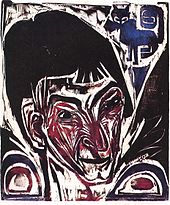
Woodcut, a type of relief impress, is the primeval printmaking technique. Information technology was probably showtime developed as a ways of printing patterns on fabric, and by the 5th century was used in China for press text and images on paper.[ commendation needed ] Woodcuts of images on newspaper developed effectually 1400 in Japan, and slightly later in Europe.[ citation needed ] These are the two areas where woodcut has been almost extensively used purely as a process for making images without text.[ commendation needed ]

Woodcuts of Stanislaw Raczynski (1903–1982)
The artist either draws a blueprint directly on a plank of woods, or transfers an drawing done on paper to a plank of forest. Traditionally, the artist then handed the piece of work to a technician, who and so uses abrupt etching tools to carve away the parts of the cake that will not receive ink.[ citation needed ] In the Western tradition, the surface of the block is then inked with the utilize of a brayer; however in the Japanese tradition, woodblocks were inked with a brush.[1] Then a sail of paper, perchance slightly damp, is placed over the block. The block is and so rubbed with a baren or spoon, or is run through a press press. If the impress is in color, separate blocks can be used for each color, or a technique called reduction printing tin exist used.
Reduction printing is a proper noun used to describe the process of using one cake to print several layers of color on one impress. Both woodcuts and linocuts can use reduction printing. This usually involves cutting a modest amount of the block away, and so printing the block many times over on dissimilar sheets earlier washing the cake, cutting more away and printing the side by side colour on top. This allows the previous color to prove through. This process can be repeated many times over. The advantages of this process is that merely i cake is needed, and that dissimilar components of an intricate pattern volition line up perfectly. The disadvantage is that once the creative person moves on to the next layer, no more prints can be fabricated.
Some other variation of woodcut printmaking is the cukil technique, made famous past the Taring Padi underground community in Java, Indonesia. Taring Padi Posters usually resemble intricately printed cartoon posters embedded with political messages. Images—usually resembling a visually circuitous scenario—are carved unto a wooden surface chosen cukilan, then smothered with printer's ink earlier pressing information technology unto media such as newspaper or canvas.
Engraving [edit]

The process was developed in Germany in the 1430s from the engraving used by goldsmiths to decorate metalwork. Engravers use a hardened steel tool called a burin to cut the design into the surface of a metal plate, traditionally made of copper. Engraving using a burin is generally a difficult skill to learn.
Gravers come up in a multifariousness of shapes and sizes that yield dissimilar line types. The burin produces a unique and recognizable quality of line that is characterized by its steady, deliberate advent and clean edges. Other tools such equally mezzotint rockers, roulettes (a tool with a fine-toothed cycle) and burnishers (a tool used for making an object smooth or shiny by rubbing) are used for texturing furnishings.
To make a print, the engraved plate is inked all over, then the ink is wiped off the surface, leaving only ink in the engraved lines. The plate is then put through a loftier-force per unit area press press together with a sail of paper (frequently moistened to soften it). The paper picks up the ink from the engraved lines, making a impress. The process can be repeated many times; typically several hundred impressions (copies) could exist printed before the printing plate shows much sign of wear, except when drypoint, which gives much shallower lines, is used.
In the 20th century, truthful engraving was revived as a serious fine art class by artists including Stanley William Hayter whose Atelier 17 in Paris and New York City became the magnet for such artists every bit Pablo Picasso, Alberto Giacometti, Mauricio Lasansky and Joan Miró.
Etching [edit]

Albrecht Dürer, Saint Jerome in his Study, 1514.
Artists using this technique include
Albrecht Dürer, Rembrandt, Francisco Goya, Wenceslaus Hollar, Whistler, Otto Dix, James Ensor, Edward Hopper, Käthe Kollwitz, Pablo Picasso, Cy Twombly, Lucas van Leyden
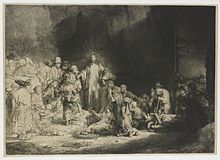
Etching is part of the intaglio family. In pure carving, a metallic plate (commonly copper, zinc, or steel) is covered with a waxy or acrylic basis. The creative person so draws through the footing with a pointed etching needle, exposing the metal. The plate is and then etched by dipping it in a bath of etchant (e.chiliad. nitric acid or ferric chloride). The etchant "bites" into the exposed metal, leaving backside lines in the plate. The remaining basis is then cleaned off the plate, and the printing process is so just the same as for engraving.
Although the outset dated etching is past Albrecht Dürer in 1515, the process is believed to have been invented by Daniel Hopfer (c.1470–1536) of Augsburg, Germany, who decorated armor in this way, and applied the method to printmaking.[2] Carving presently came to challenge engraving equally the near popular printmaking medium. Its great reward was that, unlike engraving which requires special skill in metalworking, etching is relatively easy to learn for an artist trained in drawing.
Etching prints are generally linear and often contain fine detail and contours. Lines can vary from smoothen to sketchy. An etching is opposite of a woodcut in that the raised portions of an etching remain blank while the crevices hold ink.
A non-toxic form of etching that does not involve an acid is Electroetching.
Mezzotint [edit]
An intaglio variant of engraving in which the image is formed from subtle gradations of calorie-free and shade. Mezzotint—from the Italian mezzo ("half") and tinta ("tone")—is a "dark manner" form of printmaking, which requires artists to work from dark to light. To create a mezzotint, the surface of a copper printing plate is roughened evenly all over with the assistance of a tool known as a rocker; the image is then formed by smoothing the surface with a tool known every bit a burnisher. When inked, the roughened areas of the plate will hold more than ink and print more darkly, while smoother areas of the plate hold less or no ink, and will print more than lightly or not at all. It is, however, possible to create the prototype past only roughening the plate selectively, then working from light to dark.
Mezzotint is known for the luxurious quality of its tones: first, because an evenly, finely roughened surface holds a lot of ink, allowing deep solid colors to be printed; secondly considering the process of smoothing the texture with burin, burnisher and scraper allows fine gradations in tone to exist developed.
The mezzotint printmaking method was invented past Ludwig von Siegen (1609–1680). The process was used widely in England from the mid-eighteenth century, to reproduce oil paintings and in particular portraits.
Aquatint [edit]

The sleep of Reason creates monsters, etching and aquatint past Francisco Goya, c. 1797–98
A technique used in Intaglio etchings. Similar etching, aquatint technique involves the application of acid to make marks in a metal plate. Where the etching technique uses a needle to make lines that retain ink, traditional aquatint relies on powdered rosin which is acid resistant in the ground to create a tonal effect. The rosin is applied in a lite dusting by a fan berth, the rosin is then cooked until set up on the plate. At this time the rosin tin can be burnished or scratched out to bear on its tonal qualities. The tonal variation is controlled by the level of acrid exposure over large areas, and thus the image is shaped past large sections at a time.
Contemporary printmakers too sometimes using airbrushed asphaltum or spray paint, as well as other non toxic techniques, to reach aquatint due to rosin boxes posing a fire hazard.[3]
Goya used aquatint for almost of his prints.
Drypoint [edit]
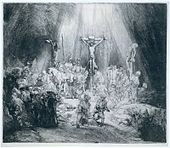
A variant of engraving, done with a sharp indicate, rather than a five-shaped burin. While engraved lines are very smoothen and hard-edged, drypoint scratching leaves a rough burr at the edges of each line. This burr gives drypoint prints a characteristically soft, and sometimes blurry, line quality. Because the pressure of printing apace destroys the burr, drypoint is useful only for very pocket-size editions; as few as ten or twenty impressions. To counter this, and permit for longer print runs, electro-plating (here chosen steelfacing) has been used since the nineteenth century to harden the surface of a plate.
The technique appears to have been invented by the Housebook Master, a south German fifteenth-century artist, all of whose prints are in drypoint only. Among the about famous artists of the old principal impress, Albrecht Dürer produced three drypoints before abandoning the technique; Rembrandt used it ofttimes, but normally in conjunction with carving and engraving.
Lithography [edit]
Artists using this technique include
Honoré Daumier, Vincent van Gogh, George Bellows, Pierre Bonnard, Edvard Munch, Emil Nolde, Pablo Picasso, Odilon Redon, Henri de Toulouse-Lautrec, Salvador Dalí, Chiliad. C. Escher, Willem de Kooning, Joan Miró, Stow Wengenroth, Elaine de Kooning, Louise Nevelson

Lithography is a technique invented in 1798 past Alois Senefelder and based on the chemical repulsion of oil and water. A porous surface, ordinarily limestone, is used; the image is drawn on the limestone with a greasy medium. Acid is practical, transferring the grease-protected design to the limestone, leaving the prototype 'burned' into the surface. Glue standard arabic, a h2o-soluble substance, is then practical, sealing the surface of the stone not covered with the drawing medium. The stone is wetted, with water staying only on the surface not covered in grease-based residue of the drawing; the rock is then 'rolled up', meaning oil ink is practical with a roller covering the entire surface; since water repels the oil in the ink, the ink adheres only to the greasy parts, perfectly inking the prototype. A canvass of dry newspaper is placed on the surface, and the prototype is transferred to the paper by the pressure of the printing printing. Lithography is known for its power to capture fine gradations in shading and very small detail.
Variations of Lithography [edit]
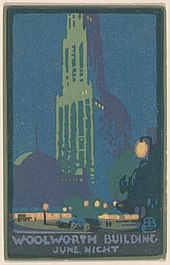
Photo-lithography captures an epitome by photographic processes on metal plates; printing is more or less carried out in the same way as stone lithography.
Halftone lithography produces an paradigm that illustrates a gradient-like quality.
Mokulito is a grade of lithography on wood instead of limestone. It was invented past Seishi Ozaku in the 1970s in Japan and was originally called Mokurito.[iv]
Screenprinting [edit]
Screen printing (occasionally known as "silkscreen", or "serigraphy") creates prints past using a fabric stencil technique; ink is simply pushed through the stencil confronting the surface of the paper, most often with the aid of a squeegee. Generally, the technique uses a natural or synthetic 'mesh' material stretched tightly across a rectangular 'frame,' much similar a stretched canvas. The fabric can be silk, nylon monofilament, multifilament polyester, or even stainless steel.[5] While commercial screen printing frequently requires high-tech, mechanical apparatuses and calibrated materials, printmakers value it for the "Exercise It Yourself" approach, and the low technical requirements, high quality results. The essential tools required are a squeegee, a mesh fabric, a frame, and a stencil. Unlike many other printmaking processes, a press press is not required, as screen press is essentially stencil printing.
Screen printing may be adapted to printing on a variety of materials, from paper, material, and canvas to safety, glass, and metallic. Artists have used the technique to impress on bottles, on slabs of granite, directly onto walls, and to reproduce images on textiles which would misconstrue under pressure from press presses.
Monotype [edit]
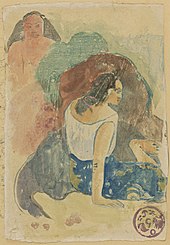

Monotyping is a type of printmaking fabricated by drawing or painting on a smooth, non-absorbent surface. The surface, or matrix, was historically a copper carving plate, just in contemporary work it can vary from zinc or glass to acrylic glass. The image is then transferred onto a canvas of paper by pressing the ii together, unremarkably using a press-press. Monotypes tin also be created by inking an unabridged surface and so, using brushes or rags, removing ink to create a subtractive image, east.g. creating lights from a field of opaque color. The inks used may exist oil based or water based. With oil based inks, the paper may be dry, in which case the image has more contrast, or the paper may be clammy, in which case the image has a x percent greater range of tones.
Unlike monoprinting, monotyping produces a unique print, or monotype, because almost of the ink is removed during the initial pressing. Although subsequent reprintings are sometimes possible, they differ profoundly from the first print and are generally considered inferior. A second impress from the original plate is chosen a "ghost print" or "cognate". Stencils, watercolor, solvents, brushes, and other tools are often used to embellish a monotype impress. Monotypes are frequently spontaneously executed and with no preliminary sketch.
Monotypes are the nigh painterly method amid the printmaking techniques, a unique print that is essentially a printed painting. The principal characteristic of this medium is found in its spontaneity and its combination of printmaking, painting, and drawing media.[6]
Monoprint [edit]
Monoprinting is a form of printmaking that uses a matrix such as a woodblock, litho stone, or copper plate, merely produces impressions that are unique. Multiple unique impressions printed from a single matrix are sometimes known as a variable edition. In that location are many techniques used in monoprinting, including collagraph, collage, manus-painted additions, and a form of tracing by which thick ink is laid down on a table, paper is placed on the ink, and the back of the paper is drawn on, transferring the ink to the paper. Monoprints can also exist made by altering the type, color, and viscosity of the ink used to create dissimilar prints. Traditional printmaking techniques, such as lithography, woodcut, and intaglio, can exist used to make monoprints.
Mixed-media prints [edit]
Mixed-media prints may use multiple traditional printmaking processes such equally etching, woodcut, letterpress, silkscreen, or even monoprinting in the creation of the print. They may also contain elements of chine colle, collage, or painted areas, and may be unique, i.e. i-off, non-editioned, prints. Mixed-media prints are often experimental prints and may be printed on unusual, not-traditional surfaces.
Digital prints [edit]
Digital prints refers to images printed using digital printers such as inkjet printers instead of a traditional printing press. Images tin can be printed to a variety of substrates including newspaper, textile, or plastic canvas.
Dye-based inks [edit]
Dye-based inks are organic (non mineral) dissolved and mixed into a liquid. Although most are synthetic, derived from petroleum, they can exist made from vegetable or creature sources. Dyes are well suited for textiles where the liquid dye penetrates and chemically bonds to the cobweb. Because of the deep penetration, more layers of fabric must lose their color before the fading is apparent. Dyes, however, are not suitable for the relatively thin layers of ink laid out on the surface of a print.
Pigment-based inks [edit]
Pigment is a finely ground, particulate substance which, when mixed or basis into a liquid to make ink or paint, does non dissolve, simply remains dispersed or suspended in the liquid. Pigments are categorized as either inorganic (mineral) or organic (synthetic).[7] Pigment-based inks have a much longer permanence than dye-based inks.[viii]
Giclée [edit]
Giclée (pron.: /ʒiːˈkleɪ/ zhee-KLAY or /dʒiːˈkleɪ/), is a neologism coined in 1991 by printmaker Jack Duganne [9] for digital prints made on inkjet printers. Originally associated with early dye-based printers information technology is at present more often refers to paint-based prints.[10] The word is based on the French word gicleur, which means "nozzle". Today fine art prints produced on big format ink-jet machines using the CcMmYK colour model are more often than not called "Giclée".
Foil imaging [edit]
In art, foil imaging is a printmaking technique made using the Iowa Foil Printer, developed by Virginia A. Myers from the commercial foil stamping procedure. This uses gold leaf and acrylic foil in the printmaking process.
Color [edit]

Printmakers apply colour to their prints in many different ways. Some coloring techniques include positive surface roll, negative surface scroll, and A la poupée. Often color in printmaking that involves carving, screen printing, woodcut, or linocut is applied by either using separate plates, blocks or screens or by using a reductionist approach. In multiple plate color techniques, a number of plates, screens or blocks are produced, each providing a unlike color. Each carve up plate, screen, or cake volition be inked upwardly in a dissimilar color and applied in a particular sequence to produce the entire movie. On average about 3 to iv plates are produced, but there are occasions where a printmaker may use up to seven plates. Every application of another plate of color will collaborate with the colour already applied to the newspaper, and this must be kept in mind when producing the separation of colors. The lightest colors are oftentimes applied first, and then darker colors successively until the darkest.
The reductionist approach to producing color is to offset with a lino or wood block that is either bare or with a simple carving. Upon each printing of color the printmaker volition and then farther cut into the lino or woodblock removing more material and and then apply another color and reprint. Each successive removal of lino or woods from the cake will expose the already printed color to the viewer of the impress. Picasso is frequently cited equally the inventor of reduction printmaking, although there is bear witness of this method in use 25 years before Picasso'southward linocuts.[11]
The subtractive color concept is also used in outset or digital print and is present in bitmap or vectorial software in CMYK or other color spaces.
Registration [edit]
In printmaking processes requiring more than one awarding of ink or other medium, the problem exists equally to how to line up properly areas of an prototype to receive ink in each application. The most obvious example of this would exist a multi-color image in which each color is applied in a separate step. The lining upward of the results of each step in a multistep printmaking process is called "registration." Proper registration results in the various components of an prototype beingness in their proper identify. But, for artistic reasons, improper registration is not necessarily the ruination of an image. Andy Warhol was known to intentionally utilize improper registration.
This tin vary considerably from process to process. It generally involves placing the substrate, generally paper, in correct alignment with the printmaking element that will be supplying it with coloration.[12]
Protective printmaking equipment [edit]
Protective clothing is very of import for printmakers who appoint in etching and lithography (closed toed shoes and long pants). Whereas in the by printmakers put their plates in and out of acid baths with their bare easily, today printmakers use safe gloves. They also wear industrial respirators for protection from caustic vapors. About acid baths are built with ventilation hoods above them.
Protective respirators and masks should have particle filters, particularly for aquatinting. As a part of the aquatinting process, a printmaker is often exposed to rosin powder. Rosin is a serious wellness hazard, especially to printmakers who, in the by, only used to hold their breath[13] using an aquatinting berth.
Print preservation [edit]
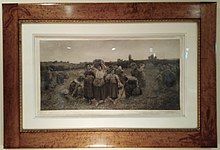
Preservation of this 140+ year-quondam print protected under drinking glass required removal of the old matting, deacidification of the print, and conservation form new matting.
Modern prints onto paper protected from the sun and moisture will last an incredible long time. Prints made using newer alkaline and acid-complimentary newspaper have a life expectancy of over i,000 years for the best newspaper and 500 years for average grades. When it comes to older prints, the condition of a print largely depends on the technique used to make the paper. Prints that are several hundred years old may be in better condition than prints that are less than fifty years old .[xiv] Many older prints will xanthous or brownish over time owing to acids in the paper and whatever matting or backing papers. To preserve/restore older prints, washing, deacidification and treatment with stain reducing agents may be in order.[fifteen] Farther, if the print is framed, archival or conservation course motion-picture show mats are essential since acids inside older or inexpensive matting will attack a print even if the print was produced using acid-free paper. Color prints can be susceptible to fading depending on the type of inks used. Lighting of sensitive prints should be limited to 50 lux (5 human foot-candles) or less and artificial lights tin exist equipped with UV-filtering sleeves or tubes.[sixteen]
Prints onto animal skins (vellum) should also be maintained at a humidity level between 25% and xl%.[17] Prints onto silk are particularly sensitive to any light including photographic camera flashes.[eighteen]
See also [edit]
- Creative person's proof
- Banhua, Chinese printmaking
- Carborundum printmaking
- Graphic design
- Line engraving
- Listing of printmakers
- Old primary print
- Shin hanga
- Sosaku hanga
- Ukiyo-east
- Visual arts
Printmakers by nationality [edit]
- Engravers past nationality
- Etchers by nationality
- Printmakers by nationality
References [edit]
- ^ Watton, Jill (2019-04-26). "Japanese Woodblock Printmaking Explained". Jackson's Art Blog . Retrieved 2021-07-24 .
{{cite spider web}}: CS1 maint: url-status (link) - ^ Cohen, Brian D. "Liberty and Resistance in the Human action of Engraving (or, Why Dürer Gave upwards on Carving)," Art in Print Vol. vii No. 3 (September–October 2017), 17.
- ^ "Exploding Rosin Box". Directly Dope Message Lath. 2010-01-28. Retrieved 2021-07-24 .
- ^ "mokulito - Danielle Creenaune". daniellecreenaune.com . Retrieved 2021-07-24 .
- ^ "Screen Material". A.West.T. World Trade Inc.
- ^ Washington printmakers' gallery Archived 2010-12-28 at the Wayback Motorcar
- ^ Printmaking FAQ at Magnolia Editions Archived 2009-04-thirteen at the Wayback Automobile
- ^ Susan Carden, Digital Fabric Printing, Bloomsbury Publishing - 2015, page 27
- ^ Johnson, Harald. Mastering Digital Printing, p.xi at Google Books
- ^ Luong, Q.-Tuan. An overview of large format color digital printing at largeformatphotography.info
- ^ "Non Picasso'due south invention - a foray into the history of reductive linoprinting. (2001) past Bunbury, Alisa. · Australian Prints + Printmaking".
- ^ "Nontoxicprint".
- ^ Smidgeon (2014-09-09). "Printmaking 101: Applying Rosin for Aquatint (Using a Rosin Box)". SMIDGEON PRESS . Retrieved 2019-07-17 .
- ^ "The Deterioration and Preservation of Paper: Some Essential Facts - Collections Care - Resources (Preservation, Library of Congress)". www.loc.gov . Retrieved 2021-01-03 .
- ^ Marianne (2017-12-16). "Cleaning Stained and Yellowed Works of Art On Paper". Marianne Kelsey Volume and Newspaper Conservator Professional person . Retrieved 2021-01-03 .
- ^ "Philadelphia Museum of Art - Inquiry : Conservation". www.philamuseum.org . Retrieved 2021-01-04 .
- ^ Marianne (2020-01-10). "How to Intendance For Vellum and Parchment Documents". Marianne Kelsey Book and Paper Conservator Professional person . Retrieved 2021-01-06 .
- ^ "How do you preserve a 100-year-old piece of silk and woman suffrage history?". National Museum of American History. 2013-08-19. Retrieved 2021-01-06 .
Sources [edit]
- What is a Impress?, from the Museum of Modern Art
- Bamber Gascoigne: How to Identify Prints: A Complete Guide to Transmission and Mechanical Processes from Woodcut to Inkjet (ISBN 0-500-28480-6)
Farther reading [edit]
- A. Hyatt Mayor (1971). Prints & people: a social history of printed pictures (full PDF) . New York: The Metropolitan Museum of Art. ISBN9780870991080.
- Beth Grabowski and Bill Fick, "Printmaking: A Complete Guide to Materials & Processes." Prentice Hall, 2009. ISBN 0-205-66453-9
- Donna Anderson Experience Printmaking. Worcester, MA: Davis Publications, 2009. ISBN 978-0-87192-982-two
- Gill Saunders and Rosie Miles Prints Now: Directions and Definitions Victoria and Albert Museum (May ane, 2006) ISBN 1-85177-480-seven
- Antony Griffiths, Prints and Printmaking, British Museum Printing, 2nd ed, 1996 ISBN 0-7141-2608-X
- Linda Hults The Print in the Western Globe: An Introductory History. Madison: University of Wisconsin Printing, 1996. ISBN 978-0-299-13700-seven
- Ballad Wax, The Mezzotint: History and Technique (Harry N. Abrams, Inc., 1990)
- James Watrous A Century of American Printmaking. Madison: University of Wisconsin Press, 1984. ISBN 0-299-09680-seven
- William Ivins, Jr. Prints and Visual Communication. Cambridge: Harvard University Press, 1953. ISBN 0-262-59002-6
- Donald Saff and Deli Sacilotto. Printmaking: History and Process. New York: Holt, Rinehart, and Winston, 1978. ISBN 978-0030856631
External links [edit]
| | Look up printmaking in Wiktionary, the free lexicon. |
- History of printmaking; glossaries
- Museum of Modern Art, New York: What Is a Impress?
- Thompson, Wendy. "The Printed Image in the Westward: History and Techniques". In Timeline of Fine art History. New York: The Metropolitan Museum of Art, 2000 – . (October 2003)
- André Béguin'due south lexicon;enormous dictionary of terms, relating more to the press than the cosmos of the image
- Another glossary - for modern prints
- Judging the Actuality of Prints by The Masters by art historian David Rudd Cycleback
- Printing techniques explained
Printmaking organizations [edit]
- Print Quango of America
- International Fine Impress Dealers Clan
- SGC International (formerly Southern Graphics Council)
- Bellebyrd - The Impress Australia blogspot by art historian Josephine Severn.
- Printmaking Artist: a glossary of contemporary prints
- Iowa Biennial - Exhibition & Annal of Contemporary Prints
- Site dedicated to the activity of printmaking and thinking creatively. Includes footage of well-known artists working at Crown Betoken Printing in San Francisco.
- Prints and Printmaking: Site devoted to Australian and Pacific printmaking practice and history
Source: https://en.wikipedia.org/wiki/Printmaking
0 Response to "Whats It Called in Art When You Copy Ink Paper Onto a Paper"
Post a Comment